Friends, you may have learned by now that, in addition to checking out unique spaces and places, my husband and I also really enjoy beer. So, imagine my delight when I discovered that Cincinnati has a tour about the city’s brewing history that also happens to take place in a super cool location: TUNNELS! I’m talking about the Ultimate Queen City Underground Tour offered by American Legacy Tours, and we had a fantastic time on this tour a couple weeks ago while visiting Cincy on our summer road trip.
Cincinnati’s Over-The-Rhine Neighborhood

Our tour started at 1:00 pm on a hot and steamy July day, and we met our guide, Dean, at the American Legacy Tours office in the Over-the-Rhine neighborhood of Cincinnati. We were ready to set out for the 2.5-hour journey through Cincinnati’s brewing history, starting with an intro about the past and present of Over-the-Rhine.
I went to college in Cincinnati (more years ago than I care to admit), and let’s just say that Over-the-Rhine was not exactly the nicest or safest neighborhood to visit. Dean mentioned that even as recently as just a decade ago, Over-the-Rhine (OTR) was considered the most dangerous neighborhood in the United States.
The fact that we were safely taking a tour through this part of town was fascinating to me, and having not visited the city in quite some time, I was surprised to see how much things had changed.
I also knew from my college days that Cincinnati had a large German immigrant population back in the 1800s, and it’s those German roots that led to the creation of Over-the-Rhine’s unusual name.
You see, back in the day the Miami and Erie Canal ran through downtown Cincinnati where Central Parkway is located today. Many of those aforementioned German immigrants lived on the northern side of the canal, and it was a Little Germany of sorts. It was felt that if you crossed over the canal into this part of town that it was as if you were crossing over the Rhine River into Germany. And so, Over-the-Rhine came to be.
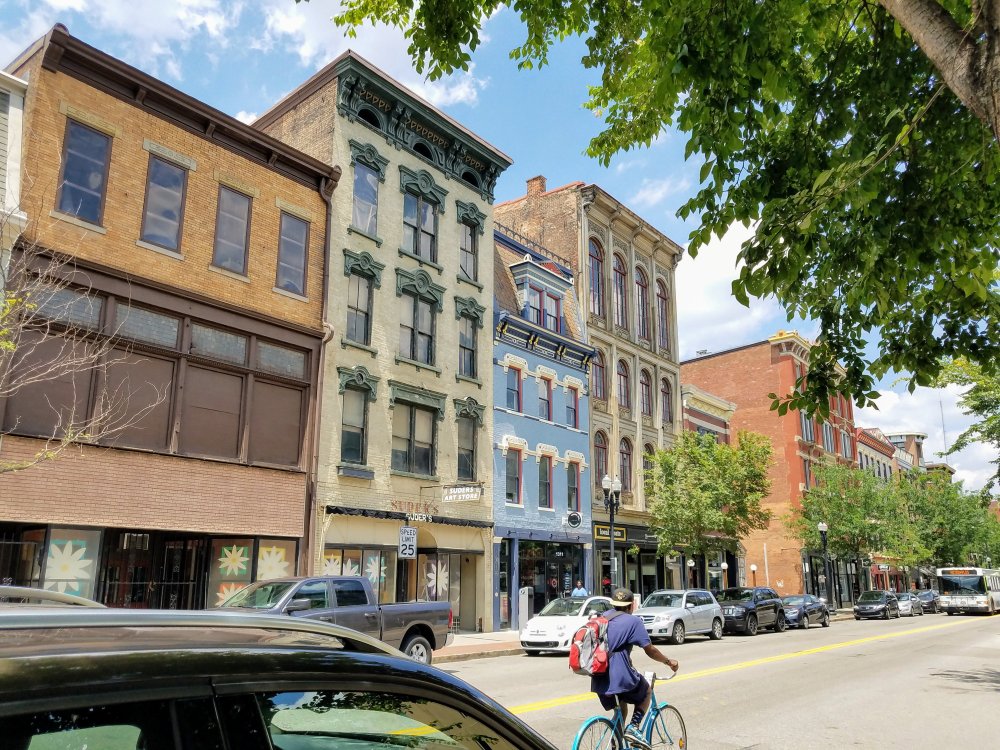
Though crime, corruption, and destruction (and even riots!) played a prominent role in OTR’s history, it’s still home to one of the country’s largest intact historic districts, with 943 buildings on the National Register of Historic Places. Some buildings have been gutted with only facades and walls remaining, awaiting new tenants and purposes, and others are still in use and look much like they did a century ago.
One such place we visited was a former entertainment venue, which is now a pizza parlor. Its claim to fame is being the place where Annie Oakley beat Frank Butler (her future husband) in a sharp-shooting contest. I hadn’t realized she was a Cincinnati native or that her real name was actually Phoebe Ann Moses. She was from the Oakley neighborhood of Cincy and her middle name was Ann and so…Annie Oakley she became!

Another historic building we visited was a catholic church called St. Francis Seraph. It was built in the 1850s in order to cater to the German Catholic population sprawling across the neighborhood, though it had previously been the site of an Irish Catholic church.

We went below the church into the crypt and saw tombstones for some 41 people. Most were Irish, having been re-interred here when the Irish Catholics moved their church closer to the river. Many of those buried here were quite young. And some were even Revolutionary War veterans!



Cincinnati’s Brewing and Beer-Drinking History
Our last stop before heading underground was to visit the building of the former Wielert’s Beer Garden, which operated from 1873 to 1919. Heinrich Wielerts, the proprietor, was a German immigrant and veteran of the Civil War, and his massive beer hall stretched back an entire city block and held around 1800 people. It also had a 40-piece orchestra, who left Wielerts for Music Hall when it opened in 1878 and they essentially became the Cincinnati Symphony Orchestra.

It was fitting that we stopped at an old beer hall on our stroll through Over-the-Rhine because Wielert’s was only just the tip of the (beer-filled) iceberg! In the 1800s and early 1900s, Over-the-Rhine was a haven for brewers and beer-drinkers. According to Dean, Cincinnati was made up of only about 7 square miles downtown in 1890, but there were 1,841 registered drinking establishments. The good people of Cincinnati drank more beer than anyone else in America (about 3 times the national average!)
On Vine Street, in the heart of Over-the-Rhine, there were 136 registered bars, taverns, and beer gardens. Basically…you could get a cold German lager beer anywhere you looked in Over-the-Rhine.
In the late 1800s, there were more than 30 breweries in Cincinnati, with about 17 in OTR alone. Sadly, during Prohibition, nearly all the breweries would close their doors for good. One such brewery that didn’t survive the “noble experiment” was the John Kauffmann Brewing Company, which was where we headed next.
Kauffmann Brewery Tunnels
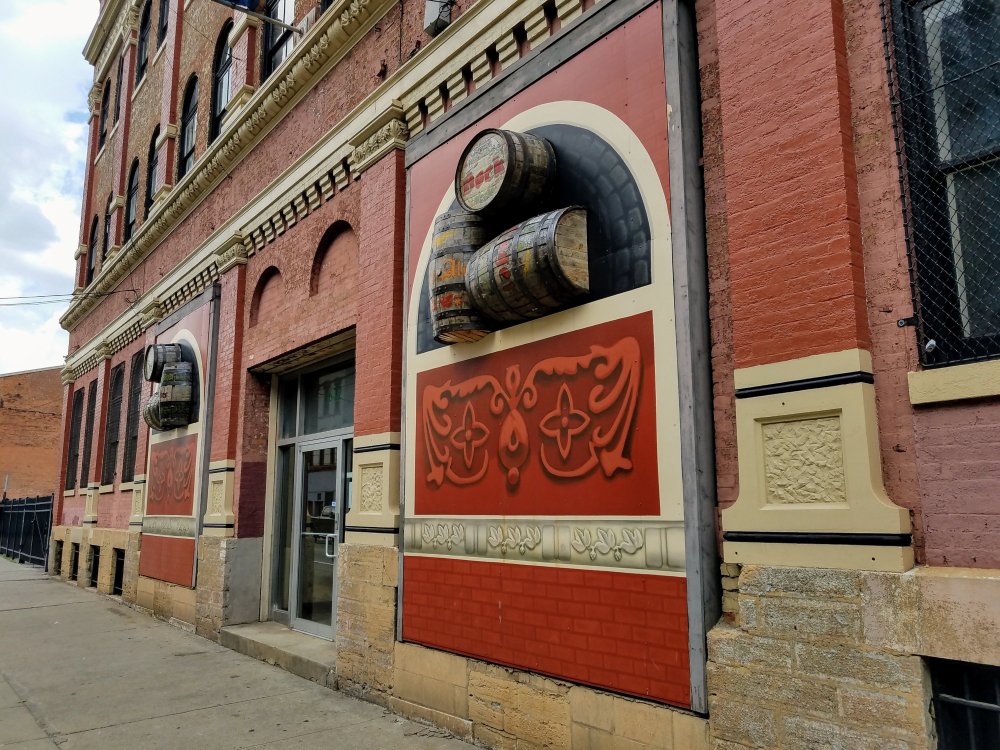
The old Kauffman brewery, one of the largest in Cincinnati in the 1800s, was located at 1622 Vine Street in Over-the-Rhine. The building that housed the brewery was built back in the 1850s and still exists today.
In the 1990s, the owner of the building received the original blueprints and was surprised to discover a little dotted line that seemed to lead to a lower level of the building that he hadn’t been aware even existed. The owner and his friends got a jackhammer and went to town on the floor and lo and behold…there WAS another level down there!
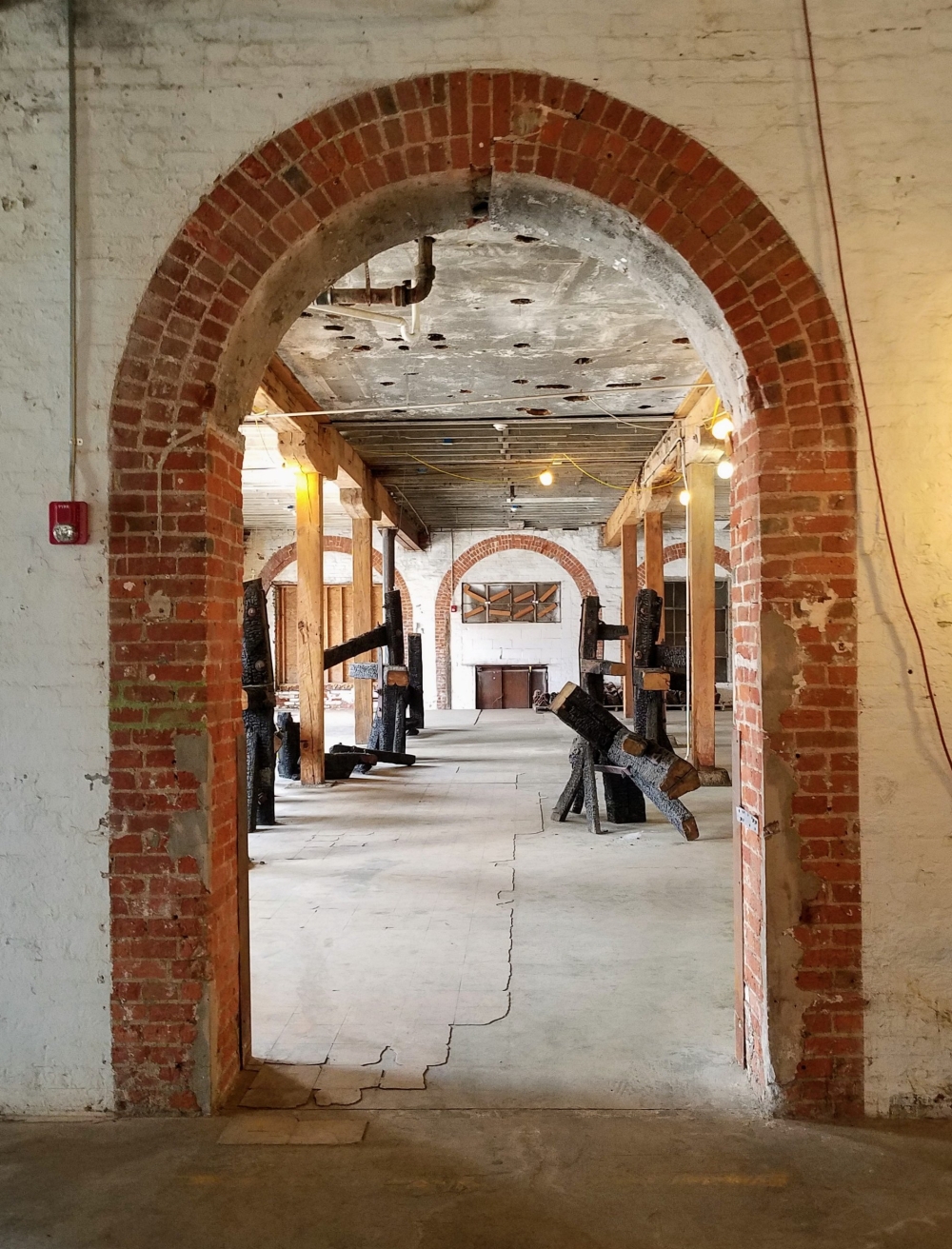
They had just discovered the old tunnels that John Kauffmann’s brewery used for making and storing beer prior to moving their operations above ground in 1905. At that time, the opening to the tunnel had been paved over and after the brewery closed in the early 1920s, no one seemed to remember the tunnels were still down there!
Luckily for us, though, they were rediscovered and we got to see them on our tour. There is only one entrance to the tunnels, and it’s a pretty narrow and steep staircase. Our group squeezed our way downstairs, and we were emptied out into a huge tunnel, which was filled with a bunch of debris. Apparently, there had been even more of it in there, but a couple years ago a crew spent several days hauling several tons of debris out, two buckets at a time, up those same tiny stairs we had just come down. Eep! What a project…





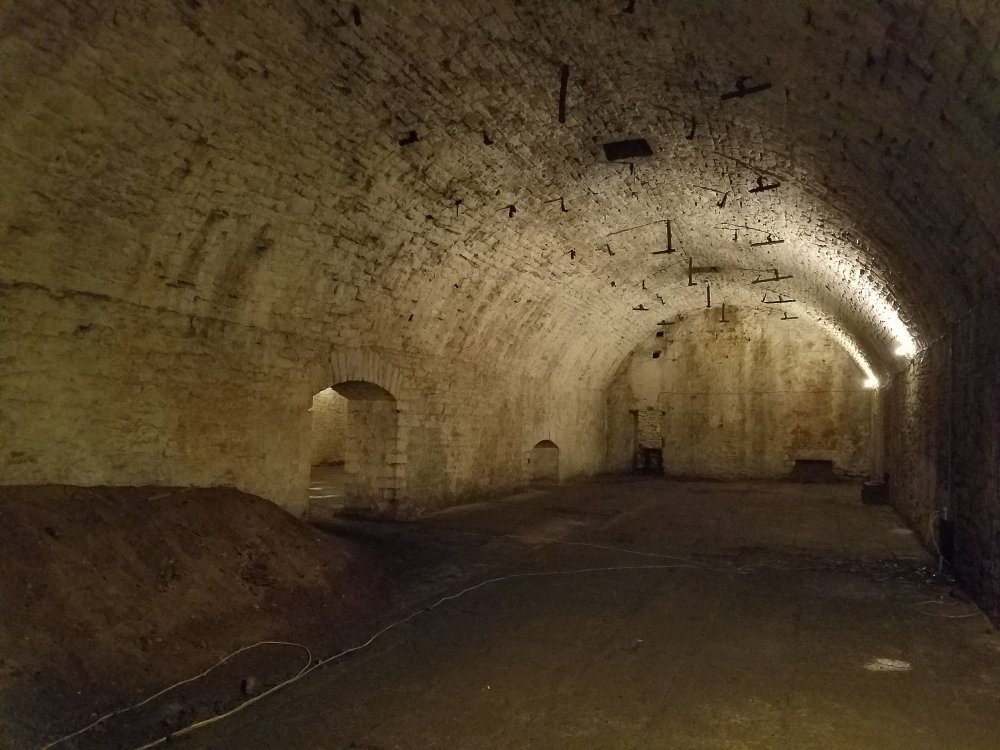




So, why tunnels, you ask? Well, lager beer needs to be brewed at a much lower temperature than ales, and with no modern refrigeration in the 1800s, the tunnels offered a place that could keep the beer’s temperature lower much easier. The tunnels were all carved by hand out of the limestone beneath the ground and include more than 20,000 square feet of space. They also stay around 58 degrees year-round, so bring a sweater if you get cold easily!
As we wandered around, we saw some of the remnants of the original fixtures left in the tunnels. Inside the walls were the remains of old, hollow oak pipes – the stainless steel of the 1800s – that were used to fill barrels with beer. Overhead were pieces of iron brackets that once held up copper pipes. These carried ice-cold water that helped to lower the temperature even more in certain parts of the tunnels so that perfect lager beer temperature could be achieved.
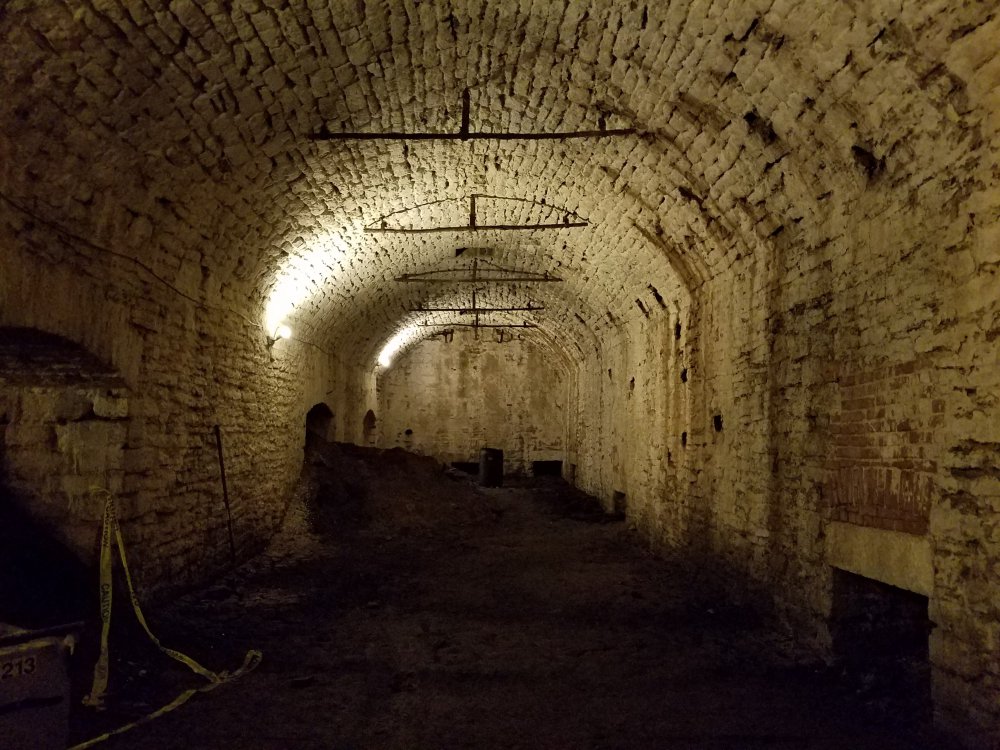
Along the walls, we also saw openings that I assumed were fireplaces, but as it turns out, they were air vents that would allow carbon dioxide (released during the brewing process) to escape out of the tunnels and up to the sidewalk so as not pose a threat to the workers down below.
When modern refrigeration became available, Kauffmann moved its beer operations above ground in 1905, removed everything that remained in the tunnels, and sealed up the entrance. They didn’t have much use for the tunnels, though they did dump a lot of coal ash other garbage down there over the next decade, which is part of the debris that you can still see piled up down there now.

Kauffmann Brewing brewed beer up until Prohibition, and then they closed their doors for good, leaving the building and tunnels empty. And the Kauffmann tunnels aren’t the only ones that exist in Cincinnati. There are at least half a dozen others that have been found already, and it’s expected that more will continue to be discovered in the future (American Legacy Tours also does an underground tunnel tour beneath Findlay Market – those tunnels were only just discovered a few years ago.)

Despite Prohibition putting most Cincinnati breweries out of business, the brewing industry in Cincy is booming again. Interestingly, we learned that Jim Koch, one of the founders of the Boston Brewing Company, which makes Sam Adams beer, is a native Cincinnatian!
They brew about 30% of Sam Adams beer in Cincinnati in what used to be the Hudepohl-Schoenling Brewery (and where Koch’s father once served as an apprentice.) And of course, newer and smaller craft breweries continue to open in the city on the regular!
One such craft brewery is Taft’s Brewing Company, which opened in 2015, and their Ale House is where our tour concluded. It would be sad (and rude) to have all that talk of beer and not get to wrap up the tour with a drink, don’t you think?
Once we emerged from the Kauffmann tunnels, we walked over to Taft’s Ale House on Race Street. Dean bought a pitcher of…you guessed it…lager beer! We each got to sample Taft’s Cold Boy lager in their beautiful alehouse, located in a former church built in the 19th century.


After our tour group broke up, my husband and I also had a flight to sample some of the other brews on tap and to enjoy a brief sit before heading on to our next activity of the day. We thoroughly enjoyed our tour, both above AND below ground, and I particularly enjoyed getting to see how wonderful downtown Cincinnati is looking these days.
So if you live in the city or will be visiting soon and you enjoy history (and beer!), I highly recommend checking out the Ultimate Queen City Underground Tour. Dean was a great guide, and you’ll be in luck if you have him. But more than anything, I think you’ll find this to be a fun and interesting stroll through Cincinnati and beer-brewing history.
And stay tuned for next week’s post. We’re leaving Ohio and heading to Kentucky for yet another underground tour! And if you want to learn about even more underground tours, we’ve got you covered!
Cheers!
Plan Your Own Visit
Where to Go
- American Legacy Tours: 1332 Vine St, Cincinnati, OH 45202
When to Go
- Tours are offered every day, often multiple times a day. Check out their schedule to see tour availability and buy tickets.
Tips for Visiting
- You will be on your feet for most of the tour, so wear comfortable shoes. I’d recommend closed-toe shoes as well for walking throughout the tunnels, which are dark and still include some piles of debris.
- Access to the tunnel is via a fairly steep and narrow staircase. This is not a handicap-accessible or stroller-friendly experience. It’s probably also not going to be super fun if you’re claustrophobic!
- Part of your tour will take place outdoors. Dress appropriately for the weather, bring some sunscreen or umbrella depending on the conditions, and stay hydrated. You’ll be offered a complimentary bottle of water when you check in for the tour, so be sure to grab one before you head out.
- There is a regular underground tour and the ultimate tour. We chose the ultimate tour because it’s longer and the tour group is smaller. It also includes a beer tasting at the end! If your time is limited, though, consider the regular tour instead.
- You may also want to check out their newest tour, the Under the Market Tour, which travels to the former Linck Brewery’s tunnels, which are currently situated under the Findlay Market.
Great post 🙂
LikeLiked by 1 person